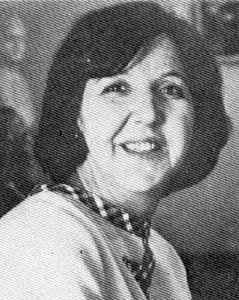Table of Contents
Naziha Salim

On April 23, 2022, the Google Doodle is dedicated to Naziha Salim and celebrates her work and life of her. She was an Iraqi contemporary art genius. Google said that she was spotlighted by the Barjeel Art Foundation in their collection of female artists on April 23, 2020.
| Name | Naziha Salim |
| Born | 1927 Istanbul, Turkey |
| Father | Hajji Mohammed Salim |
| Education | Institute of Arts in Baghdad, Ecole des Beaux-Arts (Paris) |
| Died | February 15, 2008 (aged 80–81) Baghdad, Iraq |
| Nationality | Iraqi |
| Known for | Painting |

April 23’s Doodle is a combination of two pics-Salim holding a brush and her work, which always focused on rural Iraqi women. Therefore, her works depict the rural Iraqi women and the life of peasants through old brush strokes and vivid colours. Today’s Google Doodle tribute is to the style in which Salim painted and her contribution to the arts.
Naziha Salim Life
Female artists have not received significant scholarly attention in the areas of their cultural and artistic lives. Jawad Salim’s story has overshadowed that of Naziha Salim.
Naziha Salim was born in 1927 in Istanbul to Iraqi parents, who were originally from Mosul. At the time of her birth, her father was an officer in the Ottoman army, stationed in Turkey. The family returned to Baghdad in the 1920s, when Naziha was a small child.
She was born into a family of Iraqi artists living in Turkey. Her father, Hajji Mohammed Salim was a painter, while her mother was also an artist and a skilled embroiderer.
The artist, Abdul Qadir Al Rassam, the first Iraqi to paint in the European style, was an older relative (possibly her father’s cousin). Her older brothers were also talented artists, Rashid was a political cartoonist; Su’ad Salim a painter and designer who would design the coat of arms for the Iraqi Republic; Jawad, a painter and sculptor became Iraq’s most beloved sculptor and Nizarre was also an artist.
One of the first women to be awarded a scholarship, she studied art abroad. In the 1940s, she graduated from the Baghdad Fine Arts Institution and, after gaining the scholarship continued her art education in Paris.
In the 1960s Salim returned to the Fine Arts Institute as a teacher and remained at the school until her retirement in the 1980s.
Al-Ruwwad
She was an active participant in Iraq’s arts community; a foundation member of the arts group known as Al-Ruwwad, (also known as the “Avante Garde or Primitive group”); the first group of Iraqi artists to study abroad and who sought to incorporate modern European art techniques within a distinctly Iraqi aesthetic. This group had a major influence on later generations of Iraqi artists.
Naziha Salim suffered a stroke in 2003, which left her paralyzed. She lived for another five years, dying in Baghdad at the age of 81. President Jalal Talabani called her death a “big loss to Iraqi art and culture”.
Work
She authored a history of modern Iraqi art, entitled, Iraq: Contemporary Art, published by Sartec in 1977, which continues to be used as a valuable source for the early development of Iraq’s modern art movement.
Her paintings’ themes revolve around representations of women and family; her own family, rural Iraqi women, peasant women, women at work, Mesopotamian and Arab goddesses. She participated in various experimental movements and her work often illustrated the changes taking place in women’s lives. As such, Salim, along with her contemporaries, “contributed to the opening up of news cultural, social and political spaces.”
Paintings
Dancers,
One Night’s Dream, 1978
The Martyr’s Wife, now in the Barjeel Collection
Her artworks hang at the Sharjah Art Museum and the Modern Art Iraqi Archive. No doubt she created the magic with dripping brushes and brimmed canvases. Salim’s artwork is today’s dedication, and we celebrate her long-standing contributions to the art world.
Some Facts About Naziha Salim
1. Naziha Salim was born in Turkey into a family of artists in 1927. She studied art at Baghdad’s Fine Arts Institute and the École Nationale Supérieure des Beaux-Art in Paris.
2. The Barjeel Art Foundation spotlighted Salim’s work in its collection of female artists’ works on April 23, marking a significant milestone in her career.
3. Salim’s father was a painter and her mother was an embroidery artist. She had three brothers and all of them had a remarkable contribution to arts. One of the most prominent sculptors of Iraq, Jawad Salim, is her brother.
4. Surrounded by artists around her home, Salim’s fascination for art started from an young age and she started creating her own art pieces from since then.
5. She earned a distinction in the course and received a scholarship to study at the École Nationale Supérieure des Beaux-Art in Paris.
6. She worked at Baghdad’s Fine Arts Institute and taught there until she retired.
7. Salim founded a community of foreign-educated artists, called Al-Ruwwad and was also one of the founding members of it.
8. Salim specialised in fresco and mural painting while in Paris.
9. Al-Ruwwad is an artists’ community that invites artists from across the world and incorporates art techniques into the Iraqi aesthetic.
10. She wrote a book called Iraq: Contemporary Art, which is an important source of information about the early development of Iraq’s modern art movement and her artwork are displayed at the Sharjah Art Museum and at the Modern Art Iraqi Archive.
You may also like
